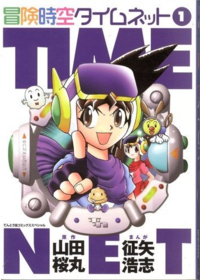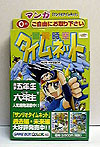Sanrio Wiki has moved from ShoutWiki. Account creation is closed to prevent spam on a company typically seen in the West for its children's media. If you want an account here (or to activate your old ShoutWiki account here) it is suggested (though you have free will) get your parent/guardian's permission to use the Internet, and contact EvieMelody (X, formally Twitter) re: account creation or article requests.
Note: Sanrio Wiki is not official and is not run by Sanrio Co., Ltd. or related parties. This wiki uses some low resolution content (images, short sound clips) to describe articles, under fair use (for the purpose of illustrating and describing an article only). All rights are reserved by Sanrio and related parties.
Sometimes this wiki may be a little slow, other times it is faster. This is likely server related. On such days, you may want to stockpile edits offline for later.
See also: Sanrio Wiki:COPPA
Bouken Jikuu Timenet
| CAUTION: The following article has received the safety notice. For more information on why this may have received the notice, see Category:Articles which received the safety notice. |

Bouken Jikuu Timenet (Japanese: 冒険時空タイムネット) is a manga created by Sakuramaru Yamada and illustrated by Hiroshi Soya, based on the video games Sanrio Timenet: Kako Hen and Mirai Hen but with only characters, monsters introduced in those games and without original Sanrio characters.
The manga is copyrighted to Timenet, which was a subsidiary company of Imagineer.
It debuted in 1999 in the magazines Shougaku Gonensei and Shougaku Rokunensei from April 1999 to February 2000 and received two tankōbon; but before this were various pilot releases (described below) as well.
The manga is notable for its controversial 'off-color humour' abusing themes including blood, nudity (censored) and near-death experience.
Chapters
Table based on the one found at Japanese Wikipedia.
See also: Bouken Jikuu Timenet: Tankōbon 1, Bouken Jikuu Timenet: Tankōbon 2
| |||||||||||||||||||||||||||||||||||||||||||||||||||||||||||||||||||||||||||||||
Preliminary/Pilot mangas
Before the main release, there was a preliminary series of manga tankōbons. This included a Summer 1999 version (original; featuring the monster Eepy on the cover. An earlier one known than that; known as "Volume 0" was also released at the Tokyo Game Show, featuring Time Surfer on the front cover.[1] There was also a later renewal of the Summer 1999 version with a different cover with Tōru on the front cover, but different to Bouken Jikuu Timenet: Tankōbon 1.[2]
Additionally for the original Summer 1999 release featuring Eepy on the cover[3], the first 1000 people who owned the tankōbon and filled out and sent the survey postcard included with the games could apply for the Hikaru Patchin Band.[4]
A smaller sized Autumn version was introduced at Tokyo Game Show for September 18th/19th and spread to game/toy stores in Japan in its own special box.[5]
Gallery
Other merchandise
Other than the previously mentioned merchandise, there have been official guidebooks covering strategy to the game and documenting it:
- Sanrio Timenet: Kako-Hen Imagineer Koushiki Guidebook (Imagineer)
- Sanrio Timenet: Mirai-Hen Imagineer Koushiki Guidebook (Imagineer)
- Sanrio Timenet: Kako-Hen & Mirai-Hen Official Guide: Rakuraku Travel Book (Famitsu)
Other promotional pieces of merchandise include the following, but there are possibly more as well:
- Sanrio Timenet 2000 New Year's Postcard
- Sanrio Timenet badge
- Sanrio Timenet Time Surfer strap
- Sanrio Timenet: Monster List Postcard
- Sanrio Timenet: Īpī Postcard
External links
References
- ↑ July 16, 1999 (archived from the original via Wayback Machine: February 11, 2003)
- ↑ Imagineer/Timenet news: August 16, 1999 (archived from the original via Wayback Machine: February 11, 2003)
- ↑ July 16, 1999 (archived from the original via Wayback Machine: February 11, 2003)
- ↑ Imagineer/Timenet news: July 23, 1999 (archived from the original via Wayback Machine: February 11, 2003)
- ↑ Imagineer/Timenet news: September 22, 1999 (archived from the original via Wayback Machine: February 11, 2003)
- ↑ サンリオタイムネットについて語る~20周年記念~ ハトの小部屋ゲーム部 (Tetuhato's blog)




